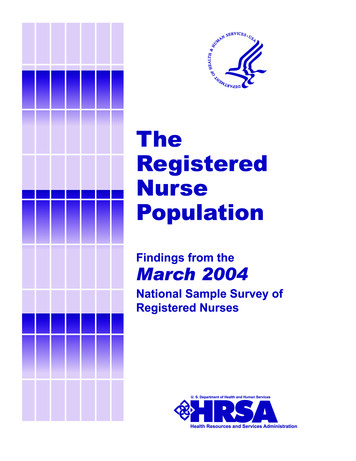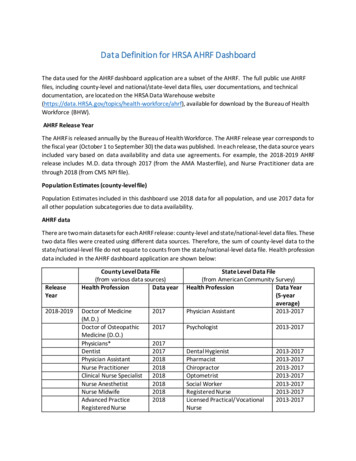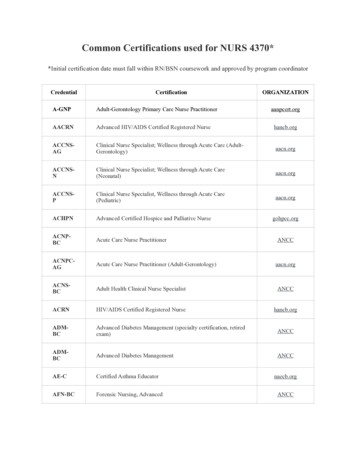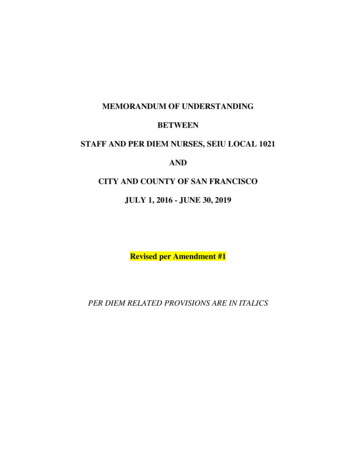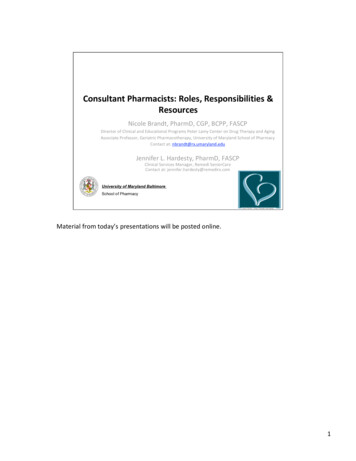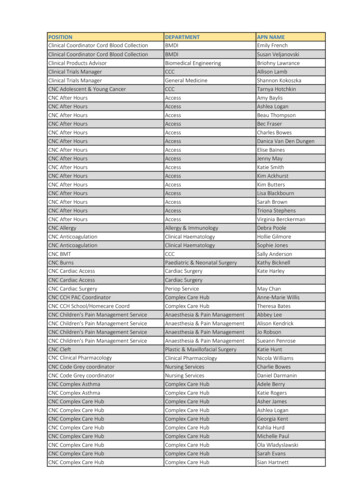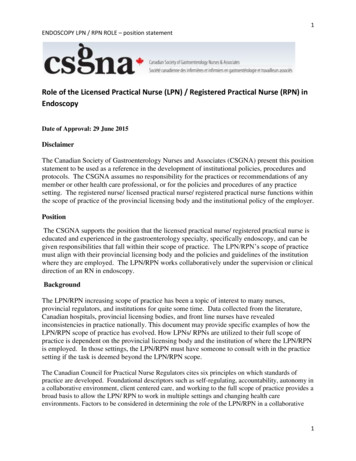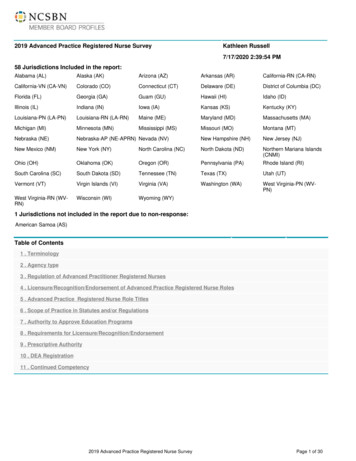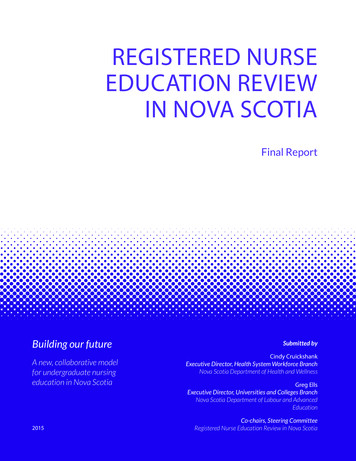
Transcription
REGISTERED NURSEEDUCATION REVIEWIN NOVA SCOTIAFinal ReportBuilding our futureA new, collaborative modelfor undergraduate nursingeducation in Nova Scotia2015Submitted byCindy CruickshankExecutive Director, Health System Workforce BranchNova Scotia Department of Health and WellnessGreg EllsExecutive Director, Universities and Colleges BranchNova Scotia Department of Labour and AdvancedEducationCo-chairs, Steering CommitteeRegistered Nurse Education Review in Nova Scotia
REGISTERED NURSEEDUCATION REVIEWIN NOVA SCOTIAFinal Report2015Submitted byCindy CruickshankExecutive Director, Health System Workforce BranchNova Scotia Department of Health and WellnessGreg EllsExecutive Director, Universities and Colleges BranchNova Scotia Department of Labour and AdvancedEducationRegistered Nurse Education Review in Nova Scotia Crown copyright, Province of Nova Scotia, 2015Co-chairs, Steering CommitteeRegistered Nurse Education Review in Nova Scotia
Steering CommitteeGovernment of Nova ScotiaDepartment of Health and WellnessDepartment of Labour and Advanced EducationCarmelle d’EntremontExecutive DirectorHealth System WorkforceGreg EllsExecutive DirectorUniversities and CollegesCindy CruickshankActing Executive DirectorHealth System WorkforceJoe MeahanHigher Education StrategistJanis BrownSenior Nursing Policy AnalystHealth System WorkforceKaren EmberlyAdministrative Assistant to Executive DirectorHealth System WorkforceShelley ArsenaultManagerProject and PortfoliosSheri RoachSenior Nursing Policy AnalystHealth System WorkforceCape Breton UniversityWillena NemethDirectorSchool of NursingDr. Robert BaileyVice-PresidentAcademic and Professional StudiesGordon MacInnisVice-PresidentFinance and OperationsDalhousie UniversityDr. Kathleen MacMillanDirectorSchool of NursingDr. Will WebsterProfessor and DeanFaculty of Health ProfessionsSt. Francis Xavier UniversityDr. Diane DuffDirectorSchool of NursingDr. Robert J. van den HoogenDeanFaculty of Science
Executive SummaryBuilding our future. A new, collaborativemodel for undergraduate nursing educationin Nova ScotiaBackground and contextIn the autumn of 2012, Nova Scotia launched areview to identify changes required to modernize andstrengthen the quality, effectiveness, sustainabilityand accountability of registered nurse undergraduateeducation. A steering committee representing theDepartments of Health and Wellness and Labourand Advanced Education, Cape Breton University(CBU), Dalhousie University (Dal) and St. FrancisXavier University (StFX) collaborated to reviewcurrent programs and delivery models, and makerecommendations on a new, collaborative model ofundergraduate nursing education to better meet currentand future population health and care delivery needs.Summary and messages of the Registered NurseEducation Review processActivities of the Registered Nurse Education Reviewincluded background research, a commissioned rapidsynthesis review of outcomes among different curriculaand models of delivery, a discussion paper led by thedirectors of the schools of nursing and a comprehensivestakeholder engagement plan that included ongoingconsultation with an external advisory group, telephoneinterviews with 32 key informants, and in-person groupconsultations with 82 stakeholders across Sydney,Antigonish and Halifax.There was strong support across the province formeaningful change in nursing education with particularattention to: reducing duplication of costs and efforts,recognition of prior learning at all points across nursingeducation, practice- and job readiness of new graduates,the whole area of clinical practice education, timing ofgraduations of large cohorts of new nurses, the need toconsider new ways to embed specialty clinical trainingwithin a generalist BScN program, and attention tointerprofessional team functioning and leadership.Background research and the various consultationspointed to the need for changes in the areas of entryinto nursing education, progression through it, andgraduation and the successful transition from studentto effective professional. There was little appetite fortinkering or marginal shifts; rather, most stakeholdersspoke to the need for a transformative leap forward.Nova Scotia’s new collaborative model forundergraduate nursing educationWith students firmly at the center of all efforts, anew, collaborative model for undergraduate nursingeducation in Nova Scotia was developed to: Offer a rich mix of shared/common services,resources and talents to students at each schoolwhile also providing specialized skills, programs andtalents that are unique to each school. Provide a level playing field for students across theprovince while meeting regional and local needs. Improve the student experience within and acrossschools of nursing and in transition from student toprofessional. Meet the needs of employers, including knowledgeand skills of generalist graduates entering highlyspecialized practice settings. Scale up access to distance education learning and arange of programs at each site. Reduce costs and duplication of effort and improveefficiency and effectiveness through sharedpurchasing and deployment of human and otherresources.The new collaborative model will facilitate access toundergraduate education across the province in twomain streams – a traditional four-year program offeredat StFX, and an accelerated program for students withprevious university courses or degrees offered at allthree schools – as well as access to an RN diplomato-BScN stream and fair and consistent recognitionof prior learning and experience for LPNs. Principlefeatures of the new Pathways to nursing educationsuccess model (see page 2) include new levels ofcollaboration among Dal, StFX and CBU to align entryrequirements and curricula, shared expertise, onlinespecialty focus electives, clear pathways to entry andprogression, innovative delivery methods, recognitionof prior learning, opportunity to transfer among schools,optimization of resources and preparation of graduatesready to meet Nova Scotia’s current and future systemneeds. The new model recasts the future of nursingeducation in Nova Scotia with an ambitious action planto launch the new direction forward starting with thefirst cohort of new students in September 2016.
Schools of NursingPathways to nursing education successKey features of the new model of undergraduateregistered nurse education in Nova ScotiaRegulatorStudentEmployersStudents and novice RNs are firmly at the centre of all we Admissioniii. Graduationand Transitionii. ProgressionStaggered program start timesFull recognition or specific blockcredit for prior learningPrerequisites, entrancerequirements and curriculumaligned across the provinceModernized content anddelivery of nursing curriculumwith common first yearcurriculum framework withineach mode of of nursingeducation deliveryOne policy for entry toaccelerated programs for allschools of nursingAccelerated nursing program ateach school፝፝፝፝፝፝፝፝፝፝Education better aligned withmodern practice settingsClinical education redesignedto share placements, clinicalinstructors, preceptors andinterprofessional facilitatorsConsolidated university andemployer clinical mentorshipand preceptor resources forconsistency and efficiencySpecialty clinical concentrationsbased on population health andprovincial care delivery needsinnovative delivery methods ateach school including accessto high-fidelity simulationtraining and distance Staggered program graduationtimesIdentify and implement bestpractice guidelines acrossschools and with clinicalpartners province wideStandardized 13-weekconsolidation experience in thepractice setting ideally wherestudent will be employedTransition to practiceexperiences that align withneeds of educational and servicesector partners and makeinnovative use of existing fundsProvince-wide strategy tosupport registration exam passratesSpecial considerations in each pillarConsult minorityunder-representedNova Scotians andincorporate bestpractices known toincrease enrolment,improve academicsuccess and supporttransition to practice.Incorporate andintegrate principlesand best practicesaround intra-andinterprofessionaleducation and practiceinto curriculum andteaching.Develop and implementa strategy for facultyrenewal includingexploration of DNPprograms for Canada.Coordinatepurchasing andfaculty deployment tomaximize efficiencyand effectiveness.
Table of Contents1Background and context2Nursing demographics and nursing education in Nova Scotia9Summary of the Registered Nurse Education Review process10Synthesis: Key messages and outcomes25From student to professional: Building blocks for a new nursingeducation model in Nova Scotia35Making it real: A high-level blueprint for action39Summary and next steps40Appendices46References
1Background and contextIn the autumn of 2012, Nova Scotia embarked on an ambitious journeyto review its undergraduate registered nurse (RN) education programsand explore changes required to modernize and strengthen theirquality, effectiveness, sustainability, and accountability.The Departments of Health and Wellness and Labour and AdvancedEducation initiated work with Cape Breton University, DalhousieUniversity and St. Francis Xavier University to review current programsand delivery models, and strengthen them to better meet currentpopulation health and care delivery needs.We cannot fight this century’s uniquehealth battles when health personnel,those truly on the frontline, havebeen educated and trained for a 20thcentury job.Dr. Margaret Chan, Director General,WHO, 2010But more than meeting today’s demands, the review and subsequenteducation reforms hold the promise to put the province in the strongestpossible position to manage emerging population health needs and thechanging nursing practices that will be required to meet them.The purpose of this review was to develop a series of recommendationsto government on a new collaborative model of baccalaureate nursingeducation in Nova Scotia to improve system quality, sustainability andaccountability. The overall vision is to have well-prepared RN graduateswho are equipped to meet the needs of the Nova Scotia health caresector across a continuum of care settings.Following establishment of a project charter, a Steering Committeecomprised of university and government representatives, informedby an Advisory Group that included employer and regulatory bodyrepresentatives (see Appendix A), met and worked extensively since2012 to develop a collaborative model that would enhance sharedplanning and delivery of effective RN undergraduate universityeducation. Supporting evidence was gathered, a rapid synthesisreview of nursing education models was commissioned and tabled, apaper proposing possible elements of a new model was circulated fordiscussion, and stakeholders from across the province and beyond wereengaged to inform the work.After extensive deliberation, the Steering Committee came to strongand unanimous agreement on the elements of an exciting, new andcollaborative model of undergraduate nursing education that puts NovaScotia at the leading edge of education reform in Canada.After extensive deliberation, theSteering Committee came to strongand unanimous agreement on theelements of an exciting, new andcollaborative model of undergraduatenursing education that puts NovaScotia at the leading edge ofeducation reform in Canada.
2Nursing demographics and nursingeducation in Nova ScotiaProvincial demographics and health system: HighlightsCanada’s second-smallest province in size, Nova Scotia is more ruralin nature than most of the country and has Canada’s second-highestpopulation density. About 55 per cent of its 922,000 citizens live inurban centres, the largest of which is the capital, Halifax RegionalMunicipality, with a population nearing 400,000.Until recently, Nova Scotia’s health care system was administeredthrough nine district health authorities (DHAs) that were “responsiblefor all hospitals, community health services, mental health services andpublic health programs in their districts.” A full range of health careservices, from primary to tertiary, is offered at various sites across theprovince. Government committed to reducing the number of DHAsfrom ten to two, and on April 1, 2015, the nine existing DHAs wereconsolidated into one provincial authority, the Nova Scotia HealthAuthority (NSHA), with the Izaak Walton Killam (IWK) Health Centreremaining as a separate authority.Nova Scotia’s health care system includes 3,374 acute-care hospitalbeds and 7,834 long-term care beds. Queen Elizabeth II HealthSciences Centre (952 beds; adult tertiary care) and IWK (203 beds;care for women, children and youth across the province ) are anomalousboth in their size and degree of specialization. Other than these Halifaxinstitutions and the hospitals in Sydney and Yarmouth, most of the 43hospitals in Nova Scotia have between 10 and 150 beds. In 2013, theConference Board of Canada gave Nova Scotia an "A" rating for hospitalbeds per capita.Nova Scotia’s registered nursesAs with all Canadian jurisdictions, RNs are the largest health providergroup in Nova Scotia. In 2014, there were 10,045 RNs registeredto practice in the province, of which 95.4 per cent were employed innursing. The other regulated nursing groups in Nova Scotia, licensed
3practical nurses and nurse practitioners, had 4,002 and 149 membersrespectively registered in 2014. Nova Scotia consistently exceeds theCanadian average for nurse-to-population ratios for all three regulatednursing groups.Figure 2 - RNs registered to practice vs. employed in nursing, NS, 2000-201310,50010,0009,5009,000Registered8,500NS 0112012201320145,000 the introduction of the Nova Scotia Nursing Strategy in 2001, theSincenumberof RNs, both registered to practice and employed in nursing,4,500has4,000rebounded to early 1990 levels. Up until 2011, the nursing10,500workforcegrew by an average of 1 per cent annually, but has since3,500leveledoff (see Figure 2).10,0003,0002,500 the decline of younger nurses entering the workforce after theWith9,5002,000closureof diploma schools in the mid-1990s, the number of RNs aged50years and older has grown steadily. At the same time,of 35 the number35-49 509,0001,500mid-careernurses, those aged 35-49, also has been steadily declining.1,0002011 2012NS Employed2013 20142002 2003 2004 2005 2006 2007 2008 2009 2010RegisteredIn8,5002014, 45.3 per cent of RNs were 50 years of ageor older upfrom 19per cent in 011201220132014650 3 - RNs employed in nursing by age group, NS, 0092010201120122013Inflow20142,0001,500 3535-49 011201220132014
4,5004,0003,5003,00042,5002,0001,500 3535-49 501,000200220032004200520062007200820092010Figure 4 - RN workforce inflow and outflow, NS, 2000-2013Faculty renewalThe new model of nursing educationin Nova Scotia cannot be deliveredwithout concurrently buildingthe teaching and research faculty.In the face of significant nursingretirements, aging of the teachingworkforce, and an existing worldwideshortage of adequately-preparednursing faculty, there is a needto ensure access to educationalpreparation for nurses who wish topursue an academic career.Strategies for faculty renewal areproposed in Appendix 220132014As shown in Figure 3, the 50-plus age group has outnumbered the35-49 year old age group for the past five years. Younger nurses, thoseunder the age of 35, were decreasing in numbers up until 2002, buthave been gradually increasing since then. This trend is the combinedresult of incremental seat increases in Nova Scotia schools of nursing(from 330 in 2007 to 401 in 2014) and improved retention of newgraduates (up from 61 per cent in 2001 to 90 per cent in 2014).For the first time in recent years, the number of RNs exiting theworkforce (outflowa) was greater than the number entering theworkforce (inflowb) in 2012 (see Figure 4). In 2014, outflow (669) onlymarginally exceeded inflow (662).The increased outflow since 2010 is likely due to the increase inretirements over the past few years. In 2014, 385 RNs over the ageof 50 exited the workforce, compared to around 200 in 2010. At thesame time new graduates entering the workforce in increasing numbershas increased the inflow — 430 new graduates from Nova Scotia andelsewhere registered in 2014 compared to 295 in 2012. Consideringcurrent nursing program attrition and graduate retention rates, it isexpected that the province’s 401 first-year seats will produce an annualaverage of 350 new graduates, approximately 305-315 of whom willremain in Nova Scotia to practice.Finally, the aging workforce issue also impacts nursing school faculty,who are about seven years older, on average, than their counterpartsin other roles in nursing. The problem is not unique to Nova Scotia orCanada. The Canadian Association of Schools of Nursing (CASN) foundthat “58.4 per cent of permanent faculty were 50 years of age or older,Outflow includes RNs who do not re-register in a particular year after having registered in the previous year. Examplesof reasons for not re-registering may include retirement, maternity leave, migration and short-term absences. bInflowincludes all incoming registrants in a particular year such as new graduates, RNs from other provinces, internationallyeducated RNs, and RNs who for any reason did not register the previous year.a
540.4 per cent were 55 years or older, and 18.8 per cent, 60 years orolder.”4 A 2013 survey of more than 42,000 American RNs5,6 found that“72% of respondents holding a principal position as full-time facultywere 50 years or older. Only 14% were younger than 40 years. Of thosewith a secondary faculty position, 63% were age 50 or older and 17%were younger than age 40.”7Registered nursing education in Nova Scotia todayA baccalaureate nursing degree is required for entry to practice in NovaScotia, along with all other Canadian jurisdictions except Quebec —and fellow Organisation for Economic Co-operation and Developmentnations including Australia, Iceland, Ireland, and New Zealand.8Undergraduate nursing education in Nova Scotia is offered at CapeBreton University (CBU),9 Dalhousie University (Dal),10 and St. FrancisXavier University (StFX).11 All three programs are approved by theCollege of Registered Nurses of Nova Scotia (CRNNS) through a jointaccreditation/approval process through CASN and CRNNS. There areno community college RN programs in Nova Scotia. Graduate nursingeducation (master’s, nurse practitioner and doctoral degrees) is offeredonly at Dal. There is one diploma program for licensed practical nurses(LPNs), offered at Nova Scotia Community College and delivered atnine campuses.12FundingThe Government of Nova Scotia presently invests 10.1 millionannually in direct support of nursing education at the three nursingschools in the province. Additionally, universities receive an operatinggrant which, in part, supports nursing programs and related costs. Onepurpose of embarking upon this Registered Nurse Education Reviewwas to ensure that the right level of funding was being invested in thenursing programs based on efficiently designed programs providingmaximal value for the taxpayers of Nova Scotia. To that end, thereview encourages universities to explore opportunities for enhancedcollaboration to improve program outcomes for students whileidentifying potential cost savings resulting from that collaboration.
6Given the fiscal realities of the province and the unprecedented fiscalchallenges facing universities in Nova Scotia, all parties have a sharedresponsibility to ensure that the new nursing education model is costeffective, thereby minimizing the funding burden upon the province,university operations and students.The government recognizes that the conversion to a collaborative andcoordinated curriculum may involve universities incurring certain, onetime developmental costs. Ideally, these expenses can be covered frominternal savings resulting from collaboration and coordination. Shouldthis not be possible, the schools will be expected to develop an itemizedbudget of costs for consideration by the province. For ongoing fundingfor nursing education, the province will consider extracting nursingeducation funding from the general operating grant and targeting itspecifically toward nursing education, tied to specific accountabilitiesand with annual reporting requirements. It is recommended that the 10.1 million being provided by the Province in direct support ofnursing education remain in place to support the 401 annual seatscurrently available until there is a change in the number of seats, or achange in the overall funding allocation mechanism.Current seats and programsUp from 330 seats in 2008, there now are 401 seats funded for entryto undergraduate nursing programs each year across Nova Scotia,dispersed as shown in Table 1. Currently all seats are filled and someprograms are over-subscribed beyond the funded numbers, resulting ina higher cost:revenue ratio for those programs.Table 1. Funded undergraduate seats and programs in Nova Scotia schools ofnursing, 2013School of NursingCBUDALST.FXNumber of seats (total 401)71210120Joint CASN/CRNNS accreditedxxx4-year BScNxxx3-year BScN, accelerated, post other university creditsxxe2-year BScN, accelerated, post other university creditsxcPrograms Offereddx2-year BScN, accelerated, post other university degreeBScN, post RN diplomaxfBScN, special program for residents of Nunavutxx185 seats at Halifax campus, 25 seats at Yarmouth campus dProgram currently being phased out; no new admissionsbeing accepted e3.5 year program fProgram currently being phased out; 11 students remaining, to be completed by 2018c
7Table 1 illustrates the multiple points of entry to the Bachelor of Sciencein Nursing (BScN) degree in Nova Scotia. Traditionally, studentsentered a four-year BScN program from high school. However, thatpattern is changing: More than half of entrants at Dal, 36-49% of CBUstudents, and 15-20% of students at StFX enter the nursing programwith university credit or other post-secondary experience. In somecases, these students were unsuccessful in applying to a BScN programand were completing non-nursing courses with a plan to reapply foradmission in a subsequent year. Both Dal and StFX have accommodatedthis demand by offering accelerated and post-degree options forindividuals with full or partial degrees. CBU does not currently have anaccelerated program option.There is significant demand for transfer to nursing programs forstudents with one or more years of university courses. However, dueto program design constraints, including the sequenced nature of corenursing courses that usually are offered only once per year, thosetransitions can be difficult. As a result, many students having significantuniversity credits still end up taking three, if not four, years to completea nursing program.Some schools across the country offer compressed, post-degreeprograms over 1.8 years (e.g. the University of British Columbia) aswell as accelerated option programs over 3-3.5 years. A few schools,like the University of Toronto and University of British Columbia, nowoffer only a two-year BScN with the undergraduate nursing curriculumcompressed into either five or six terms. They admit candidates whoalready have the pre-requisite credits in the sciences, social sciencesand humanities.While the number of post-diploma BScN programs in Canada isdecreasing, there is still a demand by RNs who earned diplomasfrom hospital schools of nursing or community colleges to be ableto complete the BScN. Diploma-prepared RNs may be exempted oroffered credit for some of the nursing courses or given block creditfor up to 50 per cent of their degree courses. Post-diploma candidatescan graduate in two years but, because many of those candidatesare working, a much longer time to complete the program is morecommon.13 After peaking nationally in 2006, the number of graduatesfrom post-diploma programs continues to wane14, likely reflectingdwindling numbers of diploma-prepared RNs still in the workforce. InInsufficient evidence exists todetermine the effectiveness of variouseducational models of delivery and/or competency-directed interventions.Stevens, Hamel & Garritty, 2013
8Nova Scotia, StFX is the only school offering an ongoing post-diplomaprogram at this time; however, this program may be phased out asdemand decreases.While nursing education models have evolved over the past twodecades to address stakeholder concerns, no single, best modelis supported by research. Instead it is important for leaders ofnursing programs to collaborate with their institutional partners andgovernment leaders to respond to local needs, national standards andhealth system trends.
9Summary of the Registered NurseEducation Review processCompelled by changing population health needs, a changing and agingnursing workforce, performance gaps identified by nurse employers,and calls for reform of nursing education from the profession itself,Nova Scotia embarked in 2012 on the Registered Nurse EducationReview to define and build a new, collaborative model of undergraduatenursing education for the province. Key project activities andmilestones are summarized in Table 2.Table 2. Key project activities and milestonesDATEDec 20122013-2014Oct 2013ACTIVITY/MILESTONEEstablishment of project charter15Steering Committee terms of reference established, membersrecruited, and meetings held regularly from Jan 2013 to Jun201416Discussion paper submitted by directors of the schools of nursing,October 10, 2013:Options for collaboration among Nova Scotia schools of nursing(undergraduate programs): Draft paper for discussion17Nov 2013Rapid synthesis review submitted by The Knowledge SynthesisGroup, KS Canada, November 7, 2013:Do outcomes vary among different curricula or models of deliveryfor pre-licensure nursing education? A rapid review18Jan 2014Stakeholder engagement plan submitted and approved bySteering Committee19Feb 2014Key informant interviews conductedMar 2014Discussion paper circulated to stakeholders:Toward a new model for collaborative undergraduate nursingeducation in Nova Scotia20May 2014Sep 2014Listening to Stakeholders sessions held in Sydney, Antigonish andHalifaxFinal report tabled
10Synthesis: Key messagesand outcomes Government perspectivesCollaboration between education and serviceGovernment decision makers have a high-level understanding ofnursing practice and nursing education, but they have a number ofconcerns. They struggle to understand why they are hearing concernsfrom employers that graduates are not meeting service needs atthe time of graduation. They assume that leaders within schools ofnursing and practice settings collaborate closely on clinical education.Governments are seeking best value solutions for the large publicinvestments in nursing for which they are accountable. In Nova Scotiathere is tremendous openness to dialogue between education andservice, but without the structures and processes needed for fullcollaboration. Collaboration is necessary to create graduates who arewell prepared for current and future practice.Efficiency, effectiveness and valueDecision makers in government have also expressed concern as towhether there is unnecessary duplication across the three universitynursing programs, or whether a single curriculum across existing siteswould be more efficient and less costly. Given the diversity across theprovince, and the need to prepare nurses for a wide range of differenttypes of practice, a single model of nursing education may not beresponsive to community needs. However, more collaboration andcommonality between the universities is clearly required.Recognition of prior learningFailure to recognize prior learning is another longstanding concern.This problem applies to those students with degrees or partial degrees,and to practicing LPNs.As in other jurisdictions, LPNs in Nova Scotia have been asking forpathways to BScN credentialing as a career mobility strategy for many
11years. Currently, none of the three universities in Nova Scotia have adesignated LPN-to-BScN pathway. As a result, experienced LPNs muststudy for a full four years after the LPN program with recognition ofonly a few credits for prior learning and none for work experience.Many LPNs want to be able to specialize and continue their careers, butthere are few opportunities for LPNs to continue to develop advancedknowledge and skills the way RNs do. An LPN-to-BScN pathway is onestrategy to graduate greater numbers of RNs (in particular LPNs havingprior caregiving experience in the health-care system) more quickly tohelp meet provincial nursing human resource needs. Currently, LPNsfrom Nova Scotia are eligible for the Post-LPN to BN program throughAthabasca University in Alberta. However, students must obtain andmaintain registration with the College of Licensed Practical Nurses ofAlberta for the duration of their program and complete part of theirclinical practice in Alberta. A collaborative study is underway betweenthe College of Licensed Practical Nurses of Nova Scotia, the NovaScotia Community College, CBU and StFX to explore LPN-to-BScNpathways in Nova Scotia. Service perspectivesPractice readinessService providers face the relentless challenge of delivering increasingamounts of care, doing so faster and with less (or at least no more)resources, and producing ever-better outcomes. Their demands oftheir own employees are no less rigorous. Mirroring many ju
Nursing demographics and nursing education in Nova Scotia Summary of the Registered Nurse Education Review process Synthesis: Key messages and outcomes From student to professional: Building blocks for a new nursing education model in Nova Scotia Making it real: A high-level blueprint for action Summary and next steps Appendices References 1 2 .
